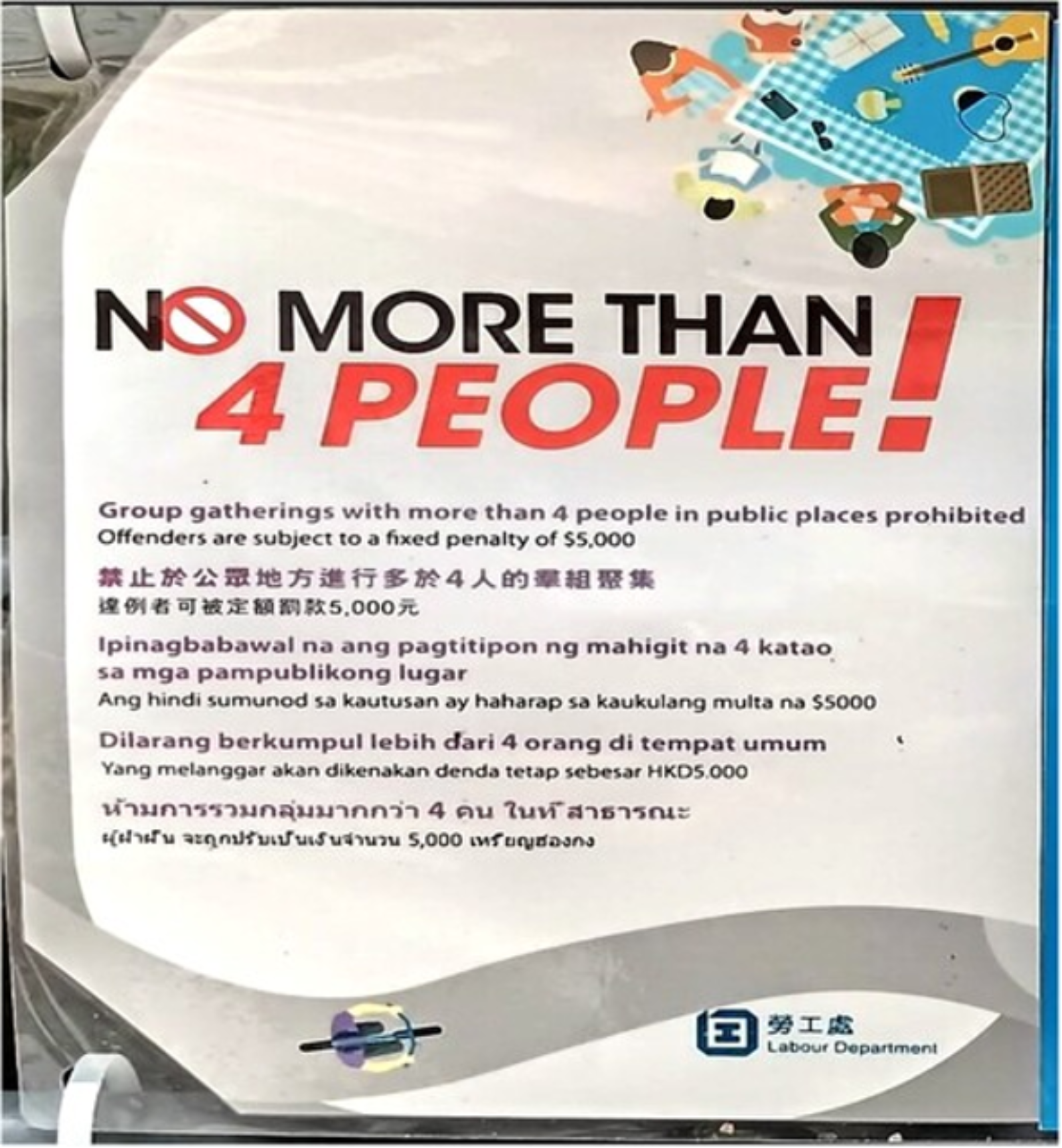Chinese-English translation scholar Chonglong Gu analyzes the linguistic landscape (LL), or the visibility of languages on signs in public spaces in Hong Kong during the COVID-19 pandemic in his article, “‘Mask Must Wear at All Times’: Top-down and Bottom-up Multilingual COVID-Scape in Hong Kong as a Prime Site of Epidemiological and Public Health Knowledge (Re)Construction during the COVID-19 Pandemic.” Hong Kong is a diverse city with a predominantly Chinese-speaking population, and is also home to people speaking South East Asian languages Bahasa Indonesia (Indonesian), Tagalog, and Thai, Indo-Aryan languages such as Hindi, Urdu, and Punjabi, and a small proportion of expatriates speaking European and African languages. Due to its British colonial history, Hong Kong uses both Chinese and English as official languages. During the COVID-19 pandemic, it was essential for communities of diverse language speakers to be aware of pandemic regulations, such as mask wearing, social distancing, and getting vaccinated, and official and informal signs featuring information about COVID-19 in English, Chinese and other languages became more common. Gu argues that conveying anti-COVID information accurately to speakers of different languages can help enhance the city’s solidarity in containing the virus and thus is vital to the government’s infection control efforts. Gu collected data using the traditional linguistic landscape approach, visiting popular locations in different districts in Hong Kong and taking photos of COVID-19 related signs from July 2021 to July 2022.
Through his data collection, Gu found that Indonesian, Tagalog, Hindi, Nepali, and Urdu were highly visible on multiple signs and posters on COVID-19, but languages that were more commonly used worldwide, such as French, Spanish, and Arabic, were rare. He attributes this finding partly to the idea of “multilingual commanding urgency” in the pandemic context, which means that officials created signs in certain languages in hopes that these language groups could be better informed about COVID-19 regulations. An interesting finding was that translations for motivational messages about fighting the pandemic and information about government welfare were also common, revealing an additional positive function of translation in facilitating the integration of multicultural communities into Hong Kong’s collective pandemic control effort. Another explanation is that the relative prevalence of Southeast Asian or South Asians when compared to Europeans or Arabs in Hong Kong. Gu observes that official signs featuring multiple languages in Hong Kong were more functional and accurate than those from other countries due to collaboration with members of the respective language groups. Private businesses and individuals also voluntarily created their own multilingual signs in compliance with government infection control measures, but these were often prone to grammatical mistakes.
In linguistically diverse cities such as Hong Kong, official narratives to educate the public on personal hygiene, protective measures, and regulations were only effective in controlling the pandemic if all Hong Kong residents, including ethnic minority groups, were aware of and cooperated with them. The presence or absence of certain languages on COVID-19 related signage determined the effectiveness of COVID-19 public health communication for their respective language speakers. Thus, Gu’s study highlights the importance of multilingual COVID-19 information signage and translation in preventing the spread of COVID-19 in Hong Kong. It invites readers to consider COVID-19 messaging in terms of content, language, and audience reception.

Image Captions:
Figure 10. Multilingual text about social distancing. Via “‘Mask Must Wear at All Times’: Top-down and Bottom-up Multilingual COVID-Scape in Hong Kong as a Prime Site of Epidemiological and Public Health Knowledge (Re)Construction during the COVID-19 Pandemic” by Chonglong Gu. Language and Intercultural Communication, vol. 24, no. 3, June 2024, pp. 195–221.Citation: Gu, Chonglong. “‘Mask Must Wear at All Times’: Top-down and Bottom-up Multilingual COVID-Scape in Hong Kong as a Prime Site of Epidemiological and Public Health Knowledge (Re)Construction during the COVID-19 Pandemic.” Language and Intercultural Communication, vol. 24, no. 3, June 2024, pp. 195–221. EBSCOhost, https://doi-org.ezproxy.lib.torontomu.ca/10.1080/14708477.2023.2225483. NON-FICTION, SCHOLARLY ARTICLE | CHINA. ll
Source Type: Scholarship on COVID-19 Studies
Country: China
Date: 01-Jun-2024
Keywords: Hong Kong, Linguistic Landscape, Multilingual Crisis Communication, and Public Health Communication